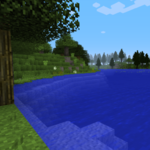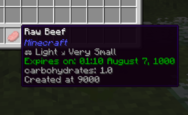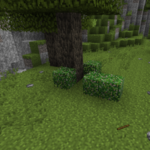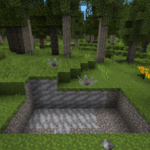Stone-Age Guide
Contents
WORK IN PROGRESS
This guide has been updated to TNG. Please see the Differences From Classic page for important changes between Classic TFC and The Next Generation.
Welcome to TerraFirmaCraft!
The following guide will help you get started playing this survival-overhaul Minecraft mod. This guide has been written with the expectations that the reader has a basic understanding of vanilla Minecraft mechanics. It will focus on aspects of the game that are different with TerraFirmaCraft, as well as a few tips and tricks for easier starting gameplay. Throughout the guide, the text will contain links to individual wiki pages for learning more information about that particular topic.
Important Differences
There are a few key differences when playing TerraFirmaCraft from vanilla Minecraft that are important to understand from the very beginning.
Health
![]()
Instead of hearts, health is represented with a red bar. When you first spawn, you will have a maximum health value of 850 HP. This value will increase and decrease depending on your nutrition. Health regenerates very slowly over time, as long as your hunger bar is at least 25% filled. Moving around in a hot spring is a fast way to heal.
Hunger
![]()
Instead of shanks of food, hunger is represented with a green bar. Food drops resemble vanilla in that each food item is the same "size", however the effects of eating them are more complex. Some foods even replenish your thirst bar by a slight amount.
Unlike vanilla, the hunger bar does slowly deplete over time even while you are standing still, or even sleeping. In addition to the slow continuous drain, hunger is primarily depleted by performing actions such as breaking blocks or attacking.
It is important to note that it is possible to starve to death in TerraFirmaCraft. When your hunger bar reaches below 25%, you will get Mining Fatigue and Weakness potion effects which will gradually get worse as you continue to starve.
Thirst
![]()
Thirst is represented with a blue bar. The thirst bar, like the hunger bar, slowly depletes over time even while you do not move. The thirst bar is replenished by drinking fresh water, which is distinguished from saltwater by the deeper blue color. Starting out, you will drink the water directly from the pool by using ![]() Right Click with an empty hand on the face of a block that is exposed to the water. A slurping sound will play, and your thirst bar will increase slightly. You can simply hold
Right Click with an empty hand on the face of a block that is exposed to the water. A slurping sound will play, and your thirst bar will increase slightly. You can simply hold ![]() Right Click to continue drinking until you are no longer thirsty. Once you have created a Jug you will be able to fill it with fresh water to drink. Jugs replenish much more of the thirst bar than drinking directly from the pond, and offer a way for you to be able to drink even when no fresh water is nearby. It is important to note that Jugs are not indestructible, and there is a random chance that it will break each time you take a drink.
Right Click to continue drinking until you are no longer thirsty. Once you have created a Jug you will be able to fill it with fresh water to drink. Jugs replenish much more of the thirst bar than drinking directly from the pond, and offer a way for you to be able to drink even when no fresh water is nearby. It is important to note that Jugs are not indestructible, and there is a random chance that it will break each time you take a drink.
Thirst is primarily depleted by sprinting and jumping. When the thirst bar is half empty, you will no longer be able to sprint. When there is only 25% of the bar left, you will get an Slowness potion effect which will gradually get worse until the thirst bar is replenished. If the thirst bar is completely empty, it is possible to die of dehydration.
Punching Wood
The tech-tree in TerraFirmaCraft is a complete overhaul of the vanilla progression system. There are no such thing as wooden tools in TerraFirmaCraft, with your first tools being made of stone. This means that you should not waste your time punching trees, as doing so will take a very long time to break the block, and will give you absolutely nothing in return.
Gravity
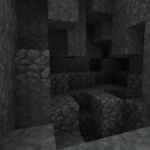
In addition to sand and gravel, the generated blocks clay dirt, dirt, grass, and cobblestone are also affected by gravity in TerraFirmaCraft. Unlike in vanilla, gravity-affected blocks are able to fall sideways in addition to straight down. This means that without a proper support system, you will not be able to create walls or ceilings out of these blocks.
Mob Spawning
TerraFirmaCraft removes vanilla hostile mobs from the surface. They will spawn below y=128, and may spawn with wrought iron weapons or armor. TFC also implements a hostile mob spawn protection system that prevents mobs from spawning in areas that you have spent a fair amount of time in above y=100. Areas with this hostile mob spawn protection will not spawn hostile mobs regardless of the current light level. With the removal of the light-level dependency for mob spawning, TerraFirmaCraft has also implemented the ability for torches to burn out. Predators including three kinds of bears, lions, panthers, cougars, saber-tooth tigers, hyenas, jackals, coyotes, and dire wolves spawn on the surface, and are aggressive in protecting their territory while they are active.
Livestock in TerraFirmaCraft, including cows, chickens, pigs, sheep, and horses spawn on initial chunk generation and will occasionally respawn, often in packs. Wild animals such as pheasants, rabbits, deer, and untamed wolves share the same spawning mechanics and neither despawn. There are climate dependent alternatives for these animals including zebu, yak, muskox, alpaca, llama, donkey, mule, boar, camel, goat, grouse, duck, quail, turkey, gazelle, wildebeest, and mongoose.
Combat
At the very beginning of the game, your best chance at surviving combat is if you avoid combat entirely, hiding and running away from any and all hostile mobs you come across. If you find yourself caught in a combat situation that you cannot escape, it is important to know that TerraFirmaCraft has implemented different damage types. Different weapons will do different types of damage, and certain mobs can be stronger or weaker against a specific damage type. For every mob except for skeletons, your best stone-age weapons are the axe and the javelin. Knives can also be used as a melee weapon, but don't deal much damage.
If you get lucky and kill a skeleton that drops a bow, you can craft arrows using rocks, sticks and feathers. Bows cannot be crafted in the stone age.
Crafting
Your inventory will only show the 2x2 crafting grid. There is a setting that you can change to enable opening a 3x3 crafting table with a hotkey (C by default) if you have a crafting table in your inventory or in your hand. The crafting table, called workbench can be made with four planks, just like in vanilla. Obtaining planks from logs requires a metal saw.
Climate & Seasons
Instead of traditional biomes, TerraFirmaCraft uses a climate system including rainfall, temperature, and plant density to determine where animals spawn, and what trees, crops, and other plant life grows in an area.
There is also an in-game calendar complete with different seasons throughout the year. The game will always start in the year 1,000 on June 1st. Spawn will be near 0,0 like vanilla and the climate will resemble a temperate region. The climate will get warmer as you move south until approximately z=20k which is essentially the equator. The climate will then get cooler again. Heading north from spawn will immediately get cooler until z=-20k, approximating the pole, and then warmer again. This cycle will continue, and is configurable.
Moving along the x-axis east or west will result in changes in rainfall and small changes in regional temperature.
Gathering Materials
Now that you understand some of the key differences between vanilla Minecraft and TerraFirmaCraft, let's move on to actual gameplay. The first thing you'll want to do is explore your world and gather materials.
Rocks and Ore
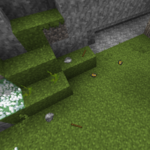
Laying scattered on the ground you will find pieces of rocks and ore. All you need to worry about starting out is gathering the rocks by either breaking the block, or using ![]() Right Click on it. The small pieces of ore indicate that there is a vein of that ore nearby underground, so it is important to take note of its location for when you later have a pickaxe and are ready to mine.
Right Click on it. The small pieces of ore indicate that there is a vein of that ore nearby underground, so it is important to take note of its location for when you later have a pickaxe and are ready to mine.
Tip: Once a piece of ore or rock has been picked up from the ground, you can place it back down with sneak+'v' by default. Only gather what you need to save on inventory space. A single stack of up to 64 rocks will be more than sufficient for your first few in-game days.
Sticks and Saplings
Similar to rocks and ores, sticks can be found laying on the ground underneath trees. You can also punch leaves which will have a chance to drop sticks and saplings when broken. It does not matter if you use your fist or most stone tools to break the leaves, the drop rate will be the same. Stone knives and later metal scythes do have an increased chance of dropping sticks from leaves. Shears will harvest the leaf block.
Tip: When a tree is chopped down, all leaves instantly despawn with it and they will not drop any sticks or saplings.
Food
As it is possible to directly starve to death in TerraFirmaCraft, gathering food is an important aspect to increase your chances of staying alive. Food has an expiration date in TerraFirmaCraft, so it is important to manage your food supply carefully. Food with different expiration dates can be stacked in the crafting grid or by using X by default. Note that the closest expiration date will be used.
Agriculture
Crops spawn randomly in the wild between the seasons of spring and late summer, and have a chance to regenerate during those seasons every year. Breaking a wild crop will give only seeds if it isn't fully mature, so you should wait until it has reached the last stage of growth before harvesting if you want food. Crop growth in TerraFirmaCraft is based off of how much time has passed since the crop was planted as well as some other factors, with crops taking a few in-game months to reach maturity. It is possible for crops to freeze to death during the colder seasons.
Tip: You will always start a new world in the beginning of summer, so some of the seeds you gather during the first year likely will not reach maturity before freezing to death if they are planted before spring of the next year.
Animal Husbandry
The amount of meat that you get from killing animals is based on your butchery skill, so the first animals that you kill will drop very little meat. With each kill your butchery skill will increase, dropping more meat than the last.
When killing animals for food, it is important to leave at least a breeding pair of one male and one female of any animals you come across that can be domesticated, as they will only very slowly respawn if you kill them. TerraFirmaCraft implements a familiarity system for interacting with animals, and most animals have a very long gestation period before giving birth, so it is unlikely to breed any babies before your first year or two in-game.
To tame livestock, feed them their preferred food (usually grain) with sneak+![]() Right Click after 6 am every day. A sound will play and the food will disappear if they ate. If they're only slightly familiarized, and they go more than 2 days without being fed, they'll lose familiarization. A white border around the heart appears when their familiarity is high enough that it won't decrease if they get hungry (30%). Animals at max familiarity will have a gold heart. Pigs will still eat rotten grain.
Right Click after 6 am every day. A sound will play and the food will disappear if they ate. If they're only slightly familiarized, and they go more than 2 days without being fed, they'll lose familiarization. A white border around the heart appears when their familiarity is high enough that it won't decrease if they get hungry (30%). Animals at max familiarity will have a gold heart. Pigs will still eat rotten grain.
To breed livestock, they must be somewhat familiarized (15%, roughly 3-4 days). Feed a male and female, get them close enough together, and the vanilla breeding hearts will appear. The female will show Pregnant or Fertilized if a WAILA-type mod is used.
Tip: Any meat you do get from killing animals will expire, so it is better to keep the animal alive until you actually need the meat.
Fruit Trees and Berry Bushes
Fruit trees and berry bushes can be found scattered across the world in areas of warmer climate. Each type of tree and bush will only be ripe during specific seasons, and will not provide food for the rest of the year. Fruit trees are a renewable resource, providing saplings when their branches are broken with an axe or saw. Berry bushes are not renewable, and the bushes that you find while out exploring are the only ones that you can get. Berry bushes can be broken and replanted elsewhere.
Clay
Clay Dirt generates in areas with a rainfall value of at least 150, meaning that it cannot be found in deserts. Clay Dirt deposits range from four to thirty blocks wide, and two to six blocks deep, and will be marked by specific flowers. Breaking it drops Clay, an important resource to leave the Stone Age.
Tip: A shovel is not required for harvesting clay, but will make the process faster.
Straw
Straw can be obtained by breaking tall or short grass with a knife, yielding a piece of straw per block, depending on the maturity of the grass. Straw is also produced as a byproduct when refining grains. It is used to craft Thatch, an important early game building block.
Tip: Tall grass will slowly grow back during warmer weather under the right conditions.
Logs
| |
|
|
|
|
|
|
|
|
|
|
|
|
|
|
|
|
Logs are gathered by chopping down trees with an axe. If you use your axe to break the bottom log of the tree, it will chop the entire tree down. If your axe does not have enough durability to fell the entire tree, as many logs as possible starting from the top of the tree will be chopped and the axe will break. Chopping trees down with a stone axe will only yield 60% of the logs from a tree.
Tip: Trees of the same type that are close together will act as one combined tree and both will fall when breaking one of the bottom log blocks.
Your First Tools
There are a few basic tools and weapons that you will be using while in the stone-age. Once you've gathered some rocks and sticks, you'll be able to make some basic tools so you can gather rest of the above listed materials.
Tip: Tools cannot be crafted together for repair in TerraFirmaCraft, so it is encouraged to just use each tool until it breaks.
Knapping
Knapping is the process of using two rocks to create heads for stone tools. ![]() Right Click while holding a stack of two or more rocks to open the knapping interface.
Right Click while holding a stack of two or more rocks to open the knapping interface.
The interface is broken up into a 5x5 grid. Clicking on each square of the grid will remove the image of the stone, chipping the rock into the desired shape. Once a piece of the rock has been removed, it cannot be put back, so be careful where you click. Whether you achieve the desired shape or not, one of your rocks will be consumed in the process. If you successfully create a specific shape, a tool head will appear to the right which can then be attached to a stick or a bone in the crafting grid to create a stone tool. JEI mod is highly encouraged to see the knapping recipes.
Tip: Completed stone tools do not stack, but tool heads will stack up to 32. At night when you are hiding from monsters, you can knap a handful of each tool head to keep in your inventory. Then during the day when your tool breaks, you can quickly combine another head with a stick or bone for a new tool.
With the exception of stone hammers and stone knives, some types of rocks will result in slightly more durable and/or efficient tools than others. This is not immediately apparent, as all stone tool icons look the same. In order of increasing durability and efficiency: Sedimentary, Metamorphic, Igneous Intrusive, Igneous Extrusive. Note however that there is only a difference of 20 uses between the highest and lowest durability stone tools, and the difference in efficiency is barely noticeable.
Tip: Some of the tools can be knapped out differently than the forms shown in JEI, feel free to experiment.
Axe
Axes are used to chop down trees, and acquire fruit tree saplings.
The axe is a rather effective weapon as well.
Hammer
In the stone-age, hammers are used to smash flux-stone and borax to create flux. The hammer can be used as a weapon.
Hoe
In the stone-age, hoes can be used to turn grass or dirt into farmland.
Javelin
Javelins can be used as a melee weapon, but they are more effectively used as a throwing spear. Hold ![]() Right Click with a javelin to draw it like a bow, releasing to fire. Javelins deal piercing damage and pass through enemies so they can be recovered by picking them up off the block it was stuck into. A javelin with low enough durability will break when hitting an entity.
Right Click with a javelin to draw it like a bow, releasing to fire. Javelins deal piercing damage and pass through enemies so they can be recovered by picking them up off the block it was stuck into. A javelin with low enough durability will break when hitting an entity.
You can store your javelins in a quiver, or just in your inventory. When throwing a javelin, the slot will refill with another javelin if you have one in a quiver (the quiver must be anywhere in your inventory, in your hotbar, or in your chestplate slot depending on the game settings). This also applies to arrows while using a bow.
Knife
Knives can be used as a weak melee weapon inflicting piercing damage, though their best use is in a crafting table to process cereal crops, cut food into smaller pieces, and scrape sheepskin. Knives are also used to collect straw from tall and short grass, scrape soaked hides, and to open the leatherworking interface.
Tip: If you mess up the double knife knapping pattern, you can still get a single knife blade by just doing one half of the pattern.
Shovel
Shovels are used to harvest blocks of dirt, clay, gravel, and sand faster. They are also required to harvest charcoal from a charcoal pit.
Firepit
At the end of the first day, you will probably want to create a firepit to make some torches, and cook any meat you've collected so you can eat it. You'll need at least five sticks, some logs to use as fuel, and optionally a few pieces of straw. First you'll need to put two sticks in the grafting grid in a diagonal pattern to make a firestarter.
Once you have a firestarter, throw (Default: Q) three sticks and one log on the ground. Then with the firestarter in your hand target the block that the sticks are resting on and hold ![]() Right Click. If it fails, try adding more straw. Once the firepit appears, drop some logs on to it to quickly add fuel. You can
Right Click. If it fails, try adding more straw. Once the firepit appears, drop some logs on to it to quickly add fuel. You can ![]() Right Click on the firepit to open its interface. If the firepit goes out, you'll need to add some fuel and then
Right Click on the firepit to open its interface. If the firepit goes out, you'll need to add some fuel and then ![]() Right Click on it with a firestarter to relight it.
Right Click on it with a firestarter to relight it.
Torches
Once you have your first firepit, you'll be able to create some torches to light up the area around you. Simply put a stick in a firepit to get two torches. Alternatively, once you've created some torches you can place one and ![]() Right Click it with a stick in your hand for quicker torch creation at the expense of only getting one torch per stick.
Right Click it with a stick in your hand for quicker torch creation at the expense of only getting one torch per stick.
It's important to note that after a configurable amount of time (Default: 48 in-game hours), or if directly exposed to rain or snow, lit torches will burn out and no longer produce light. You can also manually extinguish a torch with a ![]() Right Click from an empty hand. Torches in your inventory will never burn out, and can be used to
Right Click from an empty hand. Torches in your inventory will never burn out, and can be used to ![]() Right Click on placed torches to either relight burned out torches, or restart the countdown timer on lit torches.
Right Click on placed torches to either relight burned out torches, or restart the countdown timer on lit torches.
Pottery
Once you've gathered some clay, straw, and logs, you can start to make various pieces of pottery. ![]() Right Click while holding a stack of five or more pieces of clay to open the clay-forming interface.
Right Click while holding a stack of five or more pieces of clay to open the clay-forming interface.
The interface is broken up into a 5x5 grid. Clicking on each square of the grid will change the image of the clay, forming into the desired shape. Once a piece of the clay has been changed, it cannot be changed back, so be careful where you click. If you successfully create a specific shape, a piece of pottery will appear to the right which can then be fired in a pit kiln. If you make a mistake while clay-forming, you can close the interface to get the clay back and try again.
In order to create a pit kiln, you must first place the pottery in a 1-deep hole by holding it in your hand and using V on the bottom of the hole. You can place up to four small items or one large vessel in this manner. Then ![]() Right Click with eight pieces of straw or two thatch blocks, followed by eight logs and light the kiln using either a firestarter, a flint & steel, or by dropping a torch on the block. Once the fire finishes burning, you will be able to collect your ceramic items the same way you placed them down, or by simply breaking the block to collect all of them at once.
Right Click with eight pieces of straw or two thatch blocks, followed by eight logs and light the kiln using either a firestarter, a flint & steel, or by dropping a torch on the block. Once the fire finishes burning, you will be able to collect your ceramic items the same way you placed them down, or by simply breaking the block to collect all of them at once.
Tip: The fire from a pit kiln will light nearby flammable blocks on fire. For this reason, it is advised not to light pit kilns near wood, thatch, or other flammable blocks. Pit kilns will not be put out by rain, so you do not need to worry about putting them under a roof.
Ceramic Jug
Ceramic Jugs are used to carry water. They can be filled with ![]() Right Click on a source block of fresh water, or on a barrel that contains at least 100 mB of fresh water. Flowing water, salt water, and water from hot springs will not work. You can drink from a jug of water by holding down
Right Click on a source block of fresh water, or on a barrel that contains at least 100 mB of fresh water. Flowing water, salt water, and water from hot springs will not work. You can drink from a jug of water by holding down ![]() Right Click, the same as you would when eating food. Drinking will replenish three bars of thirst and completely empty the jug.
Right Click, the same as you would when eating food. Drinking will replenish three bars of thirst and completely empty the jug.
Tip: There is a small chance that the jug will break when you drink from it, so it is a good idea to make sure you always have a few around.
If you ![]() Right Click an empty ceramic jug, you will blow into it and play a note. The pitch of the note played is dependent on the direction up or down you are currently looking.
Right Click an empty ceramic jug, you will blow into it and play a note. The pitch of the note played is dependent on the direction up or down you are currently looking.
Small Vessel
Small Vessels are a very versatile item, but in the stone-age you will simply use them for basic storage. You can use a ceramic vessel to store up to four stacks of items. However, ceramic vessels are only able to store items with a size of small, very small, or tiny. The size of every item in your inventory is displayed on the tooltip when you place your cursor over it.
To place items into a vessel, ![]() Right Click with the vessel in hand to open up the interface. A ceramic vessel with items in it can still be stored in your inventory, or placed on the ground, thereby providing increased storage capacity.
Right Click with the vessel in hand to open up the interface. A ceramic vessel with items in it can still be stored in your inventory, or placed on the ground, thereby providing increased storage capacity.
Tip: Food stored inside of a vessel will gain the preserved quality, and will expire at a later date.
Large Vessel
Large Vessels are the lowest tier of placeable storage.
Once sealed, a large vessel can be broken and moved around. It will keep its contents so that you can fill it in one location before moving it to another. If the large vessel is not sealed when it is broken, it will dump its items onto the ground. Sealed large vessels must be carried one at a time, or otherwise you will be overburdened and unable to move.
Large vessels have nine slots for storage of items and blocks, and can hold anything that has a size of medium or smaller. They can be placed on the ground and used in a manner similar to chests.
Tip: Unlike the other pottery items, unfired large ceramic vessels will take up the entire block and can only be fired one at a time.
Bowls
Ceramic Bowls are used to craft a gold pan as well as make salads and soups.
Shelter
Once you have gathered materials and created your first tools, you will probably want to start working on some form of shelter. Since you cannot mine stone blocks at this stage you need to either find a cave or build a primitive shelter. Putting up some cobblestone blocks as the base of temporary walls might be a good extra protection in the early days, just remember that once you've placed a block of cobblestone you won't be able to break it until you have metals tools, so place them only where you need them (building near a cliff-face or on a hill may help you in designing early defenses). You can break a cobblestone block with just your fist, but it will take an extremely long time to do so, and you will get nothing in return.
Tip: Cobblestone falls sideways just like dirt, so it can't be used to make tall, 1 thick walls without proper support.
Logs and Log Piles
The logs you get from chopping down trees with an axe can be used to build both the walls and roof of a structure similar to a log cabin. You can also stack logs into log-piles by sneaking (Default: ⇧ Shift) while placing the log. Log piles can be used for walls, and have the advantage of being very fast to break. However, log piles can only be placed on top of solid blocks, or a another log pile, so it will take a lot more logs to create a wall out of log piles, and it would be very difficult to use log piles to create a ceiling.
Thatch
Thatch is one of the earliest roofing blocks available in the game. Unlike dirt and cobblestone, thatch is not affected by gravity so you can use it to create a roof for your shelter. Thatch has an advantage over logs in that it can quickly and easily be removed by hand.
Note: Players and mobs are able to move through thatch, making the block essentially useless for walls that do not contain at least one other material. You also cannot use thatch to pillar up to safety, as you will simply fall through the block when you try to jump on it. Hostile mobs will not be able to spot you if you are already hiding in a thatch enclosure, but they are able to follow you through thatch if they have been aggro'd while you were outside of the thatch. Falling through thatch will prevent fall damage for the height of the thatch blocks.
Tip: Thatch is also extremely flammable, and any thatch structures that are built near an open flame such as a pit kiln will quickly burn to the ground. Firepits are safe.
Beds
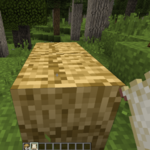
While you won't be able to sleep through the night during the stone-age, you are able to create a primitive bed that can be used to set your spawn point. You can make a straw & hide bed by placing two thatch blocks next to each other on the ground, and then using a large raw hide to ![]() Right Click on the thatch and create a bed.
Right Click on the thatch and create a bed.
Leaving the Stone Age
Eventually you will probably want to progress out of the stone-age, and create some metal tools. In order to do this, you'll need to find some ore.
To make your first metal tool head you will need to collect 10 pieces of small, copper-bearing ore: Tetrahedrite, Malachite, and Native Copper.
Prospecting
There are currently two stone-age methods of gathering ore. You can either collect them from the ground in the same manner that you gathered rocks and sticks, or by using a Gold Pan. Sluices are another option available slightly later.
Tip: Ore that is found laying on the ground indicates that there is a vein of that ore nearby, so you should always mark the location after picking up the ore piece so you can come back and find the vein once you have a pickaxe.
Processing
For more information on how to process ore and leave the stone-age, please read the Metalworking Guide.
